A Petri Net Approach for Business Process Modeling and Simulation
Abstract
:1. Introduction
- Finding the behavior pattern of a process based on organizational structures.
- Designing processes to facilitate the agile use of data.
- Using process mining to create a balance between automation and human participation in business processes.
- Investigating reference models for value creation in the context of best practices.
2. Fundamental Concepts
2.1. Supply Chain
2.2. Enterprise Resource Planning (ERP)
- Unification: allows all the functions and departments of the company to be unified in a single framework, which facilitates communication and collaboration between the different teams.
- Automation: although it is not a feature of ERPs, repetitive and well-structured tasks can be automated, avoiding errors and saving time in their execution.
- Information in real time: because ERPs are systems that work in a network, information can be updated in real time to facilitate decision making.
- Efficiency and productivity: ERPs are based on the best practices of the industry; thus, when a company implements a system of this type, it can anticipate improved efficiency and increased productivity.
- Cost reduction: costs can be reduced through improved efficiency.
- Control and visibility: management decision-making is optimized, along with issues related to different business processes, thanks the availability of reliable, timely, and truthful information.
- Regulatory Compliance: compliance with applicable laws and regulations is assured by maintaining accurate and up-to-date records.
- Scalability: ERP systems are scalable and can be adapted as the company grows or changes.
2.3. Value Chain
2.4. Petri Nets
2.5. Water Operator Agency (WOA)
3. Related Work
3.1. ProM
- Extensibility and Modularity: ProM is designed in a modular way, which means that it is possible to add and combine different plugins to adapt it to specific needs.
- Variety of Process Mining Algorithms: ProM includes a wide range of algorithms for process discovery and analysis, including model discovery, conformance checking, and rule discovery, among others.
- Process Visualization: ProM offers visualization tools to graphically represent business processes, which helps to better understand the flow of activities and events.
- Model Discovery: ProM can help to create process models from event logs. This includes the generation of flowcharts and Petri net models, among others.
- Performance Analysis: certain versions of ProM include tools to assess process performance, such as bottleneck detection and identification of areas for improvement.
- Learning Curve: ProM may have a steep learning curve for users unfamiliar with process mining or the software itself, and advanced functionalities may require a solid understanding of the underlying concepts.
- Data Format Compatibility: ProM can be picky with regard to the data formats it can handle. Users may need to prepare their data in a specific way before they can be used in the tool.
- Process Log Generator: ProM randomly generates models based on user-supplied criteria and can provide a related simulated event log; however, it does not provide a way to modify the generated model or change simulation options.
3.2. DISCO
- Intuitive User Interface: DISCO has a friendly and easy-to-use user interface, making it easy to load data, perform analysis, and view results.
- Process Analysis: DISCO offers a variety of tools to analyze business processes, including workflow visualization, pattern identification, and deviation detection.
- Model Discovery: DISCO can generate process models from event data, allowing users to understand how activities in a process unfold.
- Conformance Analysis: DISCO can be used to compare event records with a previously defined process model to identify discrepancies and deviations.
- Process Visualization: DISCO offers different types of visualization, such as flow charts, Gantt charts, and process maps, to help understand and communicate the flow of activities.
- Performance Analysis: DISCO can help to identify bottlenecks, wait times, and other areas for process improvement.
- Large Data Set Support: DISCO can handle large event datasets, which is essential for analyzing complex processes.
- Complex Events Support: DISCO provides event handling with attributes and properties, allowing for more detailed analysis.
- Cost: DISCO is a commercial tool, which means that it may have costs associated with its acquisition and licensing. This may be a limitation for individual users or small organizations with limited financial resources.
- Learning Curve: as with any specialized tool, DISCO can have a steep learning curve for those who are new to process mining or to the tool itself. Understanding advanced functionality can require considerable time and effort.
- Hardware Requirements: DISCO may require significant hardware resources to handle large event datasets and perform complex analysis, which could limit its use on systems with insufficient capabilities.
- Quality Data Dependency: as with any process mining tool, the results are highly dependent on the quality of the input data. If the data are incomplete, inconsistent, or poorly recorded, the results could be less accurate or useful.
- Data Format Support: as with many tools, support for specific data formats could be a challenge. Users may need to adjust or transform their data before use.
4. PN Basics
4.1. Relevant Aspects of the Construction of Petri Nets [37]
- is a finite set of places,
- T is a finite set of transitions
- is a set of arcs
- is a weight function
- is the initial marking
- and .
- A transition is enabled if every input place of t has tokens or more, with being the weight of the arc from p to t.
- When an enabled transition t fires, the event represented by t takes place.
- When an enabled transition t fires, tokens are removed from every input place p of t and tokens are added to every output place p of t, with being the weight of the arc from t to p.
4.2. Analysis Methods
4.3. Incidence Matrix and State Equation
5. Basic Structures of Petri Nets Applied to Business Process
- First Activity: “generate invoice (1)”.
- Next Activity: “deliver the invoice to the client personally (2)” or “send the invoice to the client via email (3)”.
- First Activity: “buyer arrives at the checkout (1)”.
- Following Activities: “cashier registers the sale of items (2)” and “ the inventory in the system is updated (3)”.
- Activity 1: “buyer buys online”.
- Activity 2: “buyer buys in-store”.
- Activity 3: “finance department generates invoice”.
- Activity 1: “client pays the advance payment of a car”.
- Activity 2: “financial company approves credit for car purchase”.
- Activity 3: “manufacturing department assembles automobile”.
5.1. Applications
- A transition t is enabled if each input location p of t is marked with at least w(p, t) tokens, where w(p, t) is the weight of the arc from p to t.
- A transition may or may not enabled the firing of a token, depending on the event that is to be fired.
- A trigger on an enabled transition t moves w(p, t) tokens from each input location p of t, where w(t, p) is the weight of the arc from t to p.
5.2. Relevant Aspects of the Construction of Petri Nets [37]
- Places are represented with circles.
- Transitions are represented by straight line segments.
- Arcs join transitions and places.
- Place p is the input to a transition t if there is an arc from p to t.
- Place p is the output of a transition t if there is an arc from t to p.
- A place can contain a positive or null number of tokens or marks, which are represented by a dot inside the circle that represents a square.
- The marking of a Petri net is the set of tokens associated with each of the squares at a given instant, and defines the state of the Petri net.
6. Business Processes of a Water Operating Agency
- Customer registrationRefers to the registration process of new users to use the services of the operating agency. This implies providing basic information, a feasibility study, and creating an account. This process is a key component of the growth strategy. The main objective is to increase the user base, which leads to an increase in revenue.
- Installation of water intakesAfter hiring, the water intake is installed, which essentially consists of making a connection from the general conduction line to the internal conduction line of the residence in question. The objective is to ensure that the water supply is granted without interruption.
- Taking readings of the water consumption measuring deviceThe process of measuring and recording the amount of water consumed by a user. This activity allows for the billing of water services and monitoring the water usage on a property. In most cases, the water reading is taken using a water meter installed on the property that measures the flow of water entering the property and records the consumption in units of cubic meters.
- Calculation of amounts to be paid for use of the serviceThe reading information is used to calculate the amount that the user must pay for water consumption. Rates may vary depending on the amount of water consumed and the policies of the operating agency. Consumption is calculated by subtracting the current month’s reading minus the previous month’s reading.
- Delivery of invoicesThe process of providing a (physical) document with the details of water consumption and the amount to be paid for the service. The water bill includes additional information such as the expiration date and rate applied.
- Receipt of payment for the serviceThe process by which users make the corresponding payment for the consumption of water they have used. This process allows the operating agency to receive the necessary funds to operate and maintain the water supply system. After making their payment, users receive confirmation of a successful transaction. Payment can be made at different financial institutions, convenience stores, or the agency’s own offices. The agency updates the user’s records to reflect the payment having been made.
- Debt agreementThis is the formal agreement between the WOA and a user who has an outstanding debt for water consumption. This agreement is generally established to recognize the debt accumulated by the user to allow them to regularize their financial situation while continuing to receive water supply services. A detailed payment plan is established describing how the amount owed is to be divided into smaller payments and in what terms they are to be made.
- Hiring agreementFormal agreement between the WOA and the user that establishes the terms and conditions under which the water supply is provided. This type of agreement is used when a user wishes to obtain regular and continuous access to drinking water services and wishes to pay the contract amount in installments.
- Debt adjustmentsAgreement between the WOA and the user to correct or modify the previous measurement of water consumption registered in a previous receipt. This is required when discrepancies in billing for water consumption are detected and adjustments need to be made to accurately reflect actual consumption. The specific reason why the water consumption adjustment is being carried out is recorded. This could be due to an incorrect meter reading, a previous billing error, or any other factor resulting in inaccurate billing.
- Feasibility studiesAnalytical and evaluative process with the objective is to determine the technical, economic, social, and environmental feasibility of providing a drinking water supply service to a certain area or community. These studies are normally requested by subdivision builders or by companies that use water as a raw material, and are crucial before undertaking any project related to water supply, as they help to ensure that informed decisions are made and that resources are used efficiently and sustainably.
- Water extraction and storageThe process of capturing water from natural sources (underground wells or springs) to treat it and make it suitable for human consumption, along with later storage in suitable facilities for distribution to the population. This process ensures access to clean and safe water for domestic, commercial, and industrial use.
- Maintenance of pipelinesThe set of regular activities that ensure the pipes and systems that transport drinking water from the supply sources to the distribution points are in optimal operating condition and meet the required quality and safety standards. This includes repairs and replacement carried out on damaged or worn pipe sections.
- Attention to emergencies (i.e., flooding)The set of actions and protocols designed to guarantee the continuity and quality of the drinking water supply service during crisis situations, natural disasters, or unforeseen events that may affect the normal operation of the WOA and the availability of water for the population. This emergency care is essential to ensure that communities have access to safe drinking water at all times, even in adverse circumstances.
- Control of measuring devicesThis refers to the procedures used to efficiently manage and supervise the water meters installed on users’ properties to ensure accurate and reliable measurement of water consumption. This implies the proper installation of meters and adequate supervision to prevent leaks as well as fraud or manipulation by users.
- Control of nonconformitiesThe process of effectively manage complaints, claims, and problems reported by users in relation to the supply of drinking water and associated services. The main objective of complaint control is to address customer concerns in a timely manner, resolve problems satisfactorily, and continuously improve the quality of service. Each complaint is recorded in detail in a computer system and assigned a unique tracking number to facilitate follow-up and resolution.
- Street repairThe process of repair and maintenance of paved surfaces, such as streets, highways, and sidewalks which have developed potholes due to WOA activities such as the installation of water intakes or maintenance of conduction lines. The objective of patching is to restore the paved surface to a safe and functional state.
- AccountingThis refers to the systematic process of recording, classifying, analyzing, and summarizing the financial and economic transactions of the WOA to provide managers with accurate and relevant information on the financial situation, performance, and cash flows, which in turn allows for decision-making and assessment of the WOA’s financial health.
- Accounts payableThe process of managing and supervising the outstanding financial obligations of the WOA towards its suppliers and creditors. Accounts payable are debts that the WOA must pay to other parties for goods and services received that have not yet been settled.
- Warehouse ControlIn this process, activities related to the storage, monitoring, and distribution of WOA materials and stocks are managed and supervised. The main objective of control is to ensure the adequate availability of products at the required time and place while minimizing storage costs and maintaining an accurate record of inventory levels.
- RecruitmentThese are the activities and steps that the WOA follows to identify, recruit, evaluate, select, and incorporate new employees into the work team. In the process, suitable candidates are chosen for vacant roles to ensure that the organization has a competent and committed talent pool.
- ShoppingThis refers to the set of steps and procedures established by legislation and government regulations to acquire goods, services, and supplies in a transparent, efficient, and legal manner. Because the WOA uses public funds, purchases are made responsibly and in accordance with the principles of competition, equity, and transparency. To this end, a budget is assigned for purchases while ensuring that expenses are within the established limits and that the availability of funds is respected.
- PayrollThese are the activities that the WOA performs to calculate, process, and distribute salaries and benefits to its employees. This process ensures that employees are properly compensated for their work in an accurate and timely manner. The relevant activities in the process are the registration of attendance and hours worked, calculation of salaries, calculation of deductions and withholdings, calculation of taxes, and printing of payment receipts.
- BudgetThis is the process of planning, assigning, monitoring, and evaluating the financial resources used to carry out the activities programmed by the WOA. This process seeks to guarantee the efficient and transparent use of public funds while complying with the objectives and priorities established by the WOA. The budget is approved by the Governing Board of the WOA to guarantee supervision and control over the use of public funds. In addition, regular monitoring of income and expenses is carried out in order to ensure that they are aligned with the budget, which is approved through internal or external audits that evaluate efficiency, effectiveness, and transparency in the use of public funds.
- Vehicle ControlThese are the measures, policies, and procedures implemented to regulate and supervise the circulation and use of vehicles of an WOA. Because these are public resources, they must be used in a rational and transparent manner. The vehicles are registered, and aspects such as the payment of tenures, use of fuel, insurance, logging of infractions, and both preventive and corrective maintenance are controlled.
7. Algorithm to Create PNs from Writing a BP
- Read the activities related to BPs.
- For each activity, create a new single structure with place and // Sequence
- If has an activity before it, then create an arc connection from to . // Selection
- If belongs to a selection structure, create an arc connection from place that represents the decision phase to . // Distribution
- If denotes an activity that must be executed in parallel with activity , then is removed and is also connected to . // Disjunction
- If is already connected with a previous activity and can also be executed after activity denoted by , a new transition t is created and the connections from to t and from t to are established. // Conjunction
- If the execution of depends on two activities denoted by and , create connections from and to .
7.1. Operation Verification
7.2. Sequence of Operation
- Op.1A. Business process. Registration in of the activities involved in the business process, indicating in each of these whether it will be connected to the next registered activity by either conjunction or disjunction (Figure 14).
- Op.3A. Petri net. Reading all the records of the table (Figure 15) determines which of the basic PN structures will be presented (selection of activity to be executed, execution of activities in parallel, execution of an activity that precedes two or more processes, or synchronization of parallel activities). Figure 16 shows the PN formed by its different places, transitions, and arcs. By clicking on the image, the user can see the token game animation.
- Op.2A. Simulation of the process. In the interface shown in Figure 17, the type of probability distribution is selected to generate the time used per activity (for this case, we use the NORMAL probability distribution), in addition to indicating the amount of random numbers to be generated. The cost field is not used here, as it is not a variable considered in this case study. The simulation information is recorded in , which is used to generate the mathematical representation of the PN by adding and averaging the execution times of each of the activities involved in the process. Figure 18 shows a fragment of the generated data; the “type-distribution” field contains the data N, corresponding to a normal distribution.
- Op.7A. Mathematical Representation. When clicking on this option, the Initial and Incidence matrices, Trigger Vector, Type Vector, and Average Time Vector are displayed on the screen. Pressing the fire button shows the PN with the movement of the token, the values of the times in that state of the process, and the generated average (see Figure 19).The algorithm measures the performance of the BPs by calculating the total time used in each activity, which represents the overall time of the process. This information is valuable for making informed decisions regarding process optimization and improvement.
- Comparison of processes. The PN is derived from the process description, allowing for multiple iterations and modifications of the same process. By measuring the performance of each proposed process, it becomes possible to select the most optimal one and make necessary adjustments within the organization. Figure 20 displays a different PN for a business process that is distinct from the one depicted in Figure 16 while having essentially the same objective. The difference lies in the approach taken for delivering the invoice to the client; the first approach involves a courier, while the second approach allows the client to download the invoice from the website or request it at the WOA. Figure 21 presents the mathematical representation of the second process.Comparison of Process 1 vs. Process 2. Figure 22 displays the matrices of the average times for Process 1 and Process 2. According to the simulated times, it can be seen that Process 2 in place 5 is more efficient.
8. Conclusions
- Development of a BP modeling algorithm. The algorithm utilizes PNs to schematize and represent business processes, providing a structured approach for modeling and analyzing the flow of activities within an organization.
- Description of basic structures of Petri nets. This study introduces the concept of basic structures, which can help in defining the arrangement of places, transitions, and arcs in a Petri net representation of business processes. These structures facilitate the understanding and analysis of process flows.
- Software platform development. A software platform was created to demonstrate the functionality of the algorithm. The platform allows users to register the activities of a business process, visualize the Petri net graph, simulate the movement of tokens, and analyze the behavior of the process through mathematical representations derived from simulation data.
- Compared to ProM and Disco, the application proposed in this document has a flatter learning curve, as the concepts handled are reduced to the following:
- (a)
- Record the time of a sample that occupies the activities related to a process (1) in any database or spreadsheet with an objective X and determine its probability distribution (Appendix A). Simulate process (1) in the proposed application.
- (b)
- Record the time of a sample that occupies the activities related to a process (2) in any database or spreadsheet with the same objective X and determine its probability distribution (Appendix A). Simulate process (2) in the proposed application.
- (c)
- After the respective simulations have been executed, compare the times of the simulations for processes (1) and (2) in order to determine which is better.
- (d)
- Notably, it is not necessary to capture the times of the activities or import them into the application’s database. The only activity necessary is to indicate the type of probability distribution and its necessary parameters.
- Performance measurement and comparison. The simulation capabilities of the software platform enable the measurement of performance for different business processes. By analyzing factors such as execution time and selecting the appropriate probability distribution, the platform provides insights into process efficiency and effectiveness. Furthermore, the mathematical representations of business processes allows for direct comparison and identification of better- and worse-performing processes.
- Comparison study. A comparison is provided between the Petri nets-based approach to modeling business processes and the generalized nets-based approach.
Author Contributions
Funding
Institutional Review Board Statement
Informed Consent Statement
Data Availability Statement
Conflicts of Interest
Appendix A. Probability Distributions
- Symmetry: in a normal distribution, the probability density curve is symmetric about its mean. This means that the values above the mean are equally symmetric to the values below the mean.
- Mean, median, and mode coincide: in a normal distribution, the mean, median, and mode are equal and lie at the center of the distribution. This contributes to the symmetry of the distribution.
- Bell shape: the shape of a normal distribution resembles a smooth and continuous bell.
- Equal probability: all values in the range have the same probability of occurring. This means that there is no bias towards any specific value.
- Defined range: the uniform distribution is defined in a specific range. All possible values within this range have the same probability.
- Mean value rule: in a uniform distribution, the mean (average) value of the distribution is equal to the sum of the endpoints of the interval divided by 2, that is, if a and b are the endpoints of the interval, then the mean value is (a + b)/2.
- Linear transformations: when taking a random variable that follows a uniform distribution and applying a linear transformation (for example, multiplication or addition), the result is a uniform distribution in the new range.
- Triangular shape: the triangular distribution is characterized by having a triangular shape in its probability density graph, meaning that the probability density is at its maximum at a point within an interval and decreases linearly towards the ends of the interval.
- Defined minimum, maximum, and mode value: in a triangular distribution, three main parameters must be defined: the minimum value (a), the maximum value (b), and the mode (c). These parameters determine the shape and range of the distribution.
- Optional symmetry: a triangular distribution can be symmetric or asymmetric depending on the location of mode (c) in relation to the interval (min, max). If c is in the center of the interval, the distribution is symmetric, while if c is closer to one of the extremes, the distribution is skewed.
- Form of the gamma distribution: the gamma distribution is a continuous probability distribution that is generally used to model the time between events in Poisson processes or to describe wait times. It has a shape that can be asymmetric and that varies depending on the parameters of the distribution.
- Parameters of the gamma distribution: the gamma distribution is defined by two parameters, namely, the shape parameter () and the scale parameter (). These parameters control the shape and scale of the distribution. The shape parameter determines the shape of the curve (higher values of produce a more skewed distribution to the right), while the scale parameter adjusts the scale of the values.
- Definite probability density function: the probability density function (PDF) of the gamma distribution is defined as a function of the parameters and , and is a mathematical function that describes the probability that a random variable takes a value in a specified interval.
- Positive values: the gamma distribution is defined only for positive values. This is due to the nature of the application, as it is typically used to model event times or rates.
- Independence: the values in a sample that follow a gamma distribution are independent of each other. This means that the occurrence of one value does not affect the occurrence of other values.
- Applications in waiting processes: the gamma distribution is useful for modeling the time between events in situations where events occur in a Poisson process, such as time between phone calls, queue arrivals, or equipment failures, among others.
- Waiting process model: the exponential distribution is commonly used to model the time between events in a Poisson process. Therefore, it is especially applicable for modeling events that occur independently at a constant rate.
- Exponential decay: the probability density function (PDF) of the exponential distribution has an exponential decay form. This means that the probability of an event occurring in a given interval decreases exponentially as time passes.
- Rate parameter: the exponential distribution is defined by a single parameter, often denoted as (lambda), which represents the average rate of occurrence of events. Its inverse value is known as the scale parameter ().
- Positive values: as with other time-related distributions, the exponential distribution is defined only for positive values, as it is designed to model wait times between events.
- Independence: the times between events in an exponential distribution are independent. The occurrence of one event does not affect the occurrence of future events.
- Lack of memory: lack of memory means that the probability of an event occurring in a future interval does not depend on how much time has elapsed since the last event. In other words, the exponential distribution has no “memory” of past events.
References
- Dumas, M.; Fournier, F.; Limonad, L.; Marrella, A.; Montali, M.; Rehse, J.R.; Accorsi, R.; Calvanese, D.; De Giacomo, G.; Fahland, D.; et al. Augmented business process management systems: A research manifesto. arXiv 2022, arXiv:2201.12855. [Google Scholar]
- Kartono, A.; Soediantono, D. Application Suggestion of ISO 9001: 2015 Quality Management System in the Defense Industry: A Literature Review. Int. J. Soc. Manag. Stud. 2022, 3, 27–38. [Google Scholar]
- Rahman, A.; Ratnawati, Y. Justifying enterprise resource planning (ERP) investment: A case study using technology, organization, and environment (TOE) framework. J. Contemp. Account. 2021, 3, 130–138. [Google Scholar] [CrossRef]
- Vergidis, K.; Tiwari, A.; Majeed, B. Business process analysis and optimization: Beyond reengineering. IEEE Trans. Syst. Man Cybern. Part C (Appl. Rev.) 2007, 38, 69–82. [Google Scholar] [CrossRef]
- van der Aalst, W.M. Business process management as the “Killer App” for Petri nets. Softw. Syst. Model. 2015, 14, 685–691. [Google Scholar] [CrossRef]
- van Hee, K.M.; Sidorova, N.; van der Werf, J.M. Business process modeling using petri nets. In Transactions on Petri Nets and Other Models of Concurrency VII; Springer: Berlin/Heidelberg, Germany, 2013; pp. 116–161. [Google Scholar]
- Reijers, H.A. Business Process Management: The evolution of a discipline. Comput. Ind. 2021, 126, 103404. [Google Scholar] [CrossRef]
- van der Aalst, W.M.; Carmona, J. Process Mining Handbook; Springer Nature: Berlin/Heidelberg, Germany, 2022. [Google Scholar]
- Beerepoot, I.; Di Ciccio, C.; Reijers, H.A.; Rinderle-Ma, S.; Bandara, W.; Burattin, A.; Calvanese, D.; Chen, T.; Cohen, I.; Depaire, B.; et al. The biggest business process management problems to solve before we die. Comput. Ind. 2023, 146, 103837. [Google Scholar] [CrossRef]
- Atanassov, K.; Andonov, V. Generalized nets and intuitionistic fuzzy pairs as tools for modelling of flexible manufacturing systems. Notes Intuition. Fuzzy Sets 2020, 26, 40–69. [Google Scholar] [CrossRef]
- Kindler, E.; Rubin, V.; Schäfer, W. Process Mining and Petri Net Synthesis. In Proceedings of the Business Process Management Workshops, Vienna, Austria, 4–7 September 2006; Eder, J., Dustdar, S., Eds.; Springer: Berlin/Heidelberg, Germany, 2006; pp. 105–116. [Google Scholar]
- Reitsma, E.; Hilletofth, P.; Johansson, E. Supply chain design during product development: A systematic literature review. Prod. Plan. Control 2021, 34, 1–18. [Google Scholar] [CrossRef]
- García, L.A.M. Gestión Logística Integral-2da Edición: Las Mejores Prácticas en la Cadena de Abastecimiento; Ecoe Ediciones: Bogotá, Colombia, 2016. [Google Scholar]
- Hamilton, S. Maximizing Your ERP System: A Practical Guide for Managers; McGraw Hill Professional: New York, NY, USA, 2003. [Google Scholar]
- Al Jafa, H. Improving ERP software selection process by integrating QFD with AHP approach. Netw. Intell. Stud. 2020, 8, 157–167. [Google Scholar]
- Heredia, D.A.V.; Ceballos, F.; Sanchez-Torres, G. Simulation-Based Improvement Procedure for Small-Scale Shoe Manufacturing Companies. J. Adv. Manuf. Syst. 2018, 17, 23–33. [Google Scholar] [CrossRef]
- Zamora, E.A. Value chain analysis: A brief review. Asian J. Innov. Policy 2016, 5, 116–128. [Google Scholar] [CrossRef]
- Jyotish, N.K.; Singh, L.K.; Kumar, C. A state-of-the-art review on performance measurement petri net models for safety critical systems of NPP. Ann. Nucl. Energy 2022, 165, 108635. [Google Scholar] [CrossRef]
- México, G. Portal Interactivo de Gestión del Agua. 2021. Available online: https://agua.org.mx/ (accessed on 11 May 2023).
- Sivaraman, E.; Kamath, M. On the use of Petri nets for business process modeling. In Proceedings of the IIE Annual Conference; 2002; p. 1. Available online: https://citeseerx.ist.psu.edu/doc/10.1.1.19.2334 (accessed on 11 May 2023).
- Deesukying, J.; Vatanawood, W. Generating of business rules for Coloured Petri Nets. In Proceedings of the 2016 IEEE/ACIS 15th International Conference on Computer and Information Science (ICIS), Okayama, Japan, 26–29 June 2016; pp. 1–6. [Google Scholar]
- Sintoris, K.; Vergidis, K. Extracting business process models using natural language processing (NLP) techniques. In Proceedings of the 2017 IEEE 19th Conference on Business Informatics (CBI), Thessaloniki, Greece, 24–27 July 2017; Volume 1, pp. 135–139. [Google Scholar]
- ElMadany, H.; Alfonse, M.; Aref, M. Forecasting in Enterprise Resource Planning (ERP) Systems: A Survey. In Digital Transformation Technology; Springer: Singapore, 2022; pp. 395–406. [Google Scholar]
- Qin, J.; Zhao, N.; Xie, Z.; Mo, Q. Business Process Analysis Method Based on Petri Nets. In Proceedings of the 2017 4th International Conference on Information Science and Control Engineering (ICISCE), Changsha, China, 21–23 July 2017; pp. 218–223. [Google Scholar]
- Yao, Q.; Zhang, J.; Wang, H. Business process-oriented software architecture for supporting business process change. In Proceedings of the 2008 International Symposium on Electronic Commerce and Security, Guangzhou, China, 3–5 August 2008; pp. 690–694. [Google Scholar]
- Rosa, M.L.; Aalst, W.M.V.D.; Dumas, M.; Milani, F.P. Business process variability modeling: A survey. ACM Comput. Surv. (CSUR) 2017, 50, 1–45. [Google Scholar] [CrossRef]
- ZareRavasan, A.; Jeyaraj, A. Evolution of Information Systems Business Value Research: Topic Modeling Analysis. J. Comput. Inf. Syst. 2022, 63, 555–573. [Google Scholar] [CrossRef]
- Ouardani, A.; Esteban, P.; Paludetto, M.; Pascal, J.C. A Meta-modeling Approach for Sequence Diagrams to Petri Nets Transformation within the requirements validation process. In Proceedings of the European Simulation and Modeling Conference, Toulouse, France, 23–25 October 2006; pp. 345–349. [Google Scholar]
- Verbeek, H.; Buijs, J.; Van Dongen, B.; van der Aalst, W.M. Prom 6: The process mining toolkit. Proc. BPM Demonstr. Track 2010, 615, 34–39. [Google Scholar]
- Kalenkova, A.A.; De Leoni, M.; Van Der Aalst, W.M. Discovering, analyzing and enhancing BPMN models using ProM. In Proceedings of the 12th International Conference on Business Process Management, BPM 2014, Haifa, Israel, 7–11 September 2014; pp. 36–41. [Google Scholar]
- van Dongen, B.F.; Van der Aalst, W.M. A Meta Model for Process Mining Data. In Proceedings of the EMOI-INTEROP 2005, Porto, Portugal, 13–14 June 2005; Volume 160, p. 30. [Google Scholar]
- Vanden Broucke, S.; Vanthienen, J.; Baesens, B. Straightforward Petri Net-based Event Log Generation in ProM. SSRN Electron. J. 2014. [Google Scholar] [CrossRef]
- Gomes, A.F.D.; Wanzeller, C.; Fialho, J. Comparative Analysis of Process Mining Tools. In Proceedings of the CAPSI 2021, 12–16 October 2021. [Google Scholar]
- Günther, C.W.; Rozinat, A. Disco: Discover Your Processes. BPM (Demos) 2012, 940, 40–44. [Google Scholar]
- Fluxicon. Process Mining for Professionals. 2023. Available online: https://fluxicon.com/disco/ (accessed on 11 May 2023).
- Bilousova, L.; Gryzun, L.; Sivochka, I. Petri Nets Android application as a mobile aid for students’ mastering modelling. J. Phys. Conf. Ser. 2021, 1840, 012033. [Google Scholar] [CrossRef]
- Wang, X.; Zhang, X.; Li, T.; Liu, J.; Chen, Q. Correctness of aspect-oriented business process modeling. Bus. Process. Manag. J. 2018, 24, 537–566. [Google Scholar] [CrossRef]
- Murata, T. Petri nets: Properties, analysis and applications. Proc. IEEE 1989, 77, 541–580. [Google Scholar] [CrossRef]
- Levin, R.I.; Rubin, D.S. Statistics for Management; Prentice Hall: Kent, OH, USA, 1991. [Google Scholar]

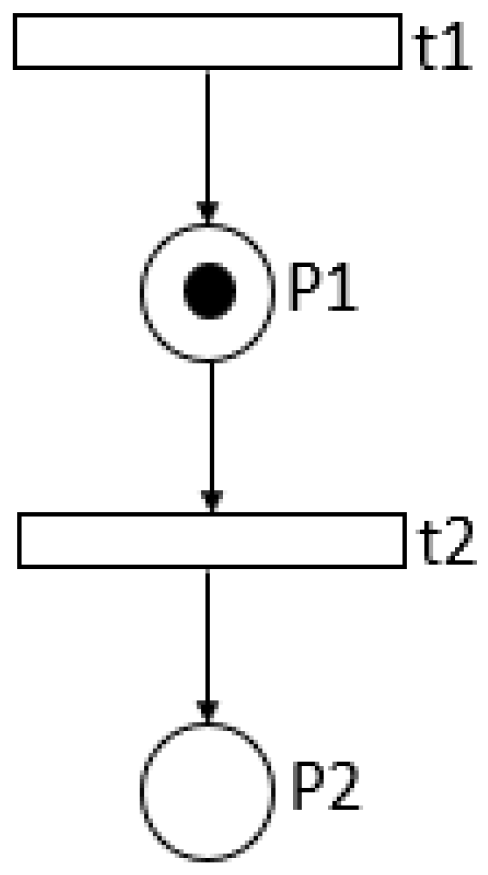
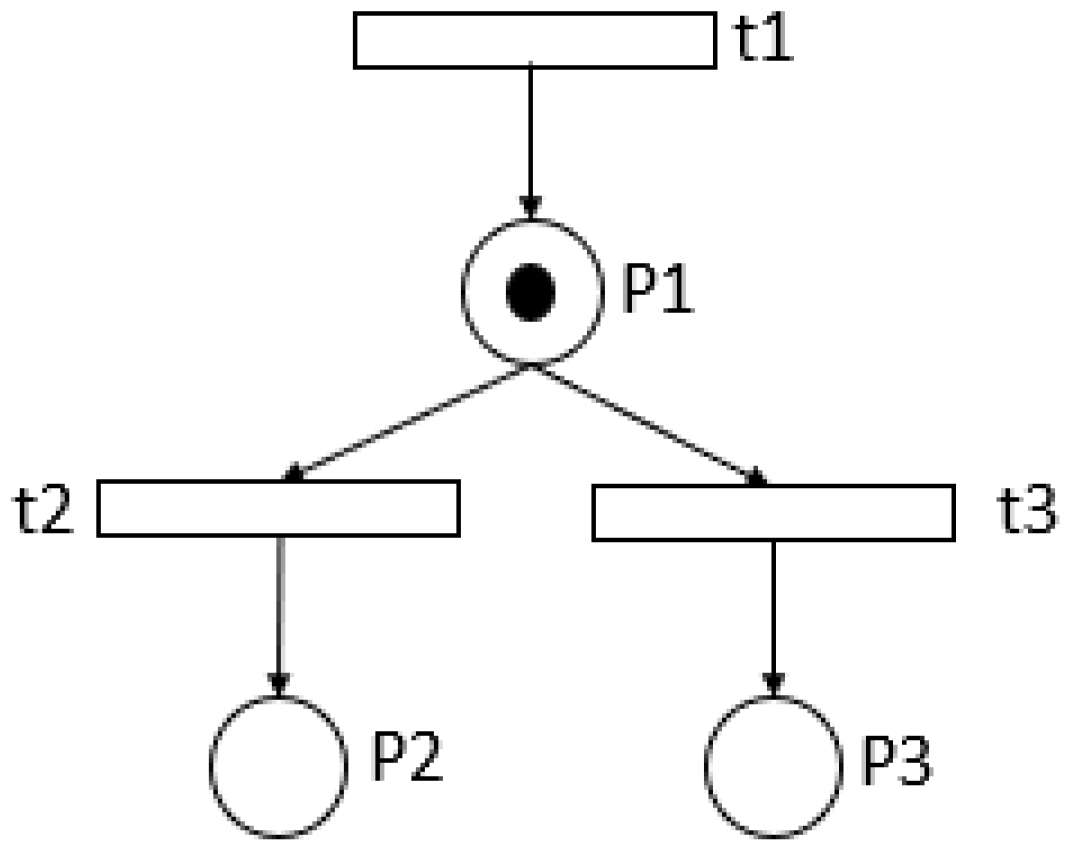
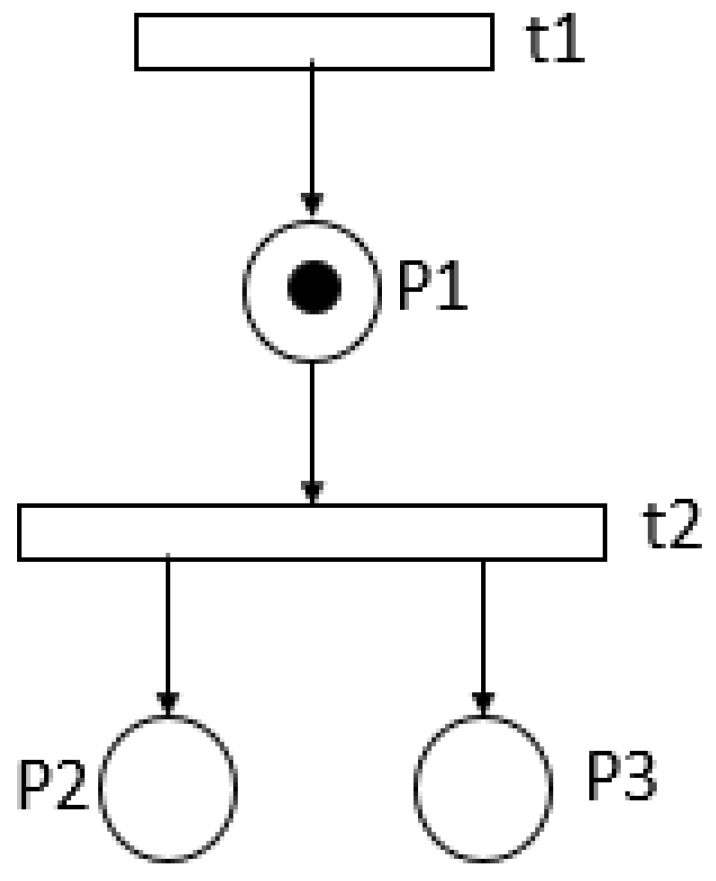


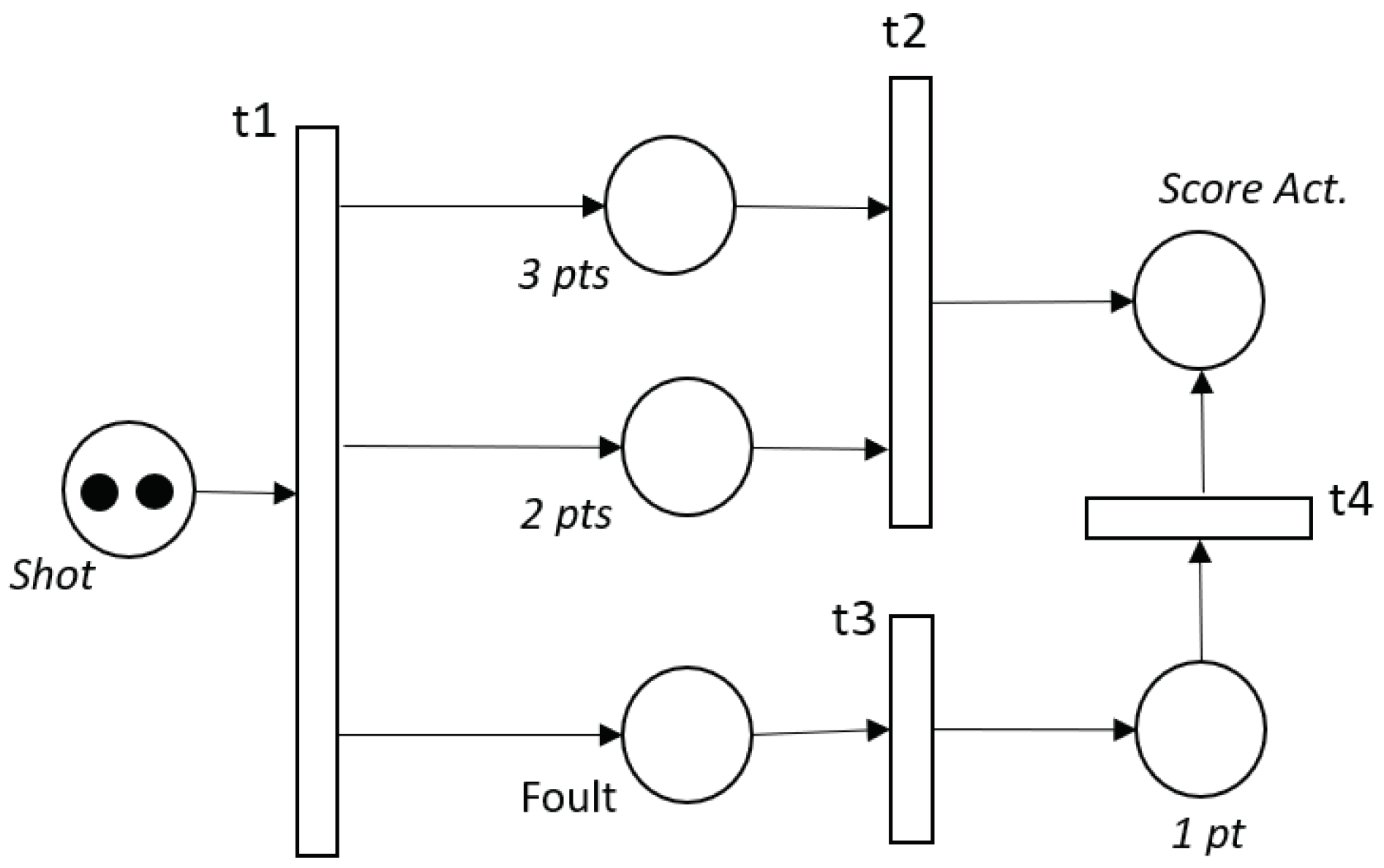



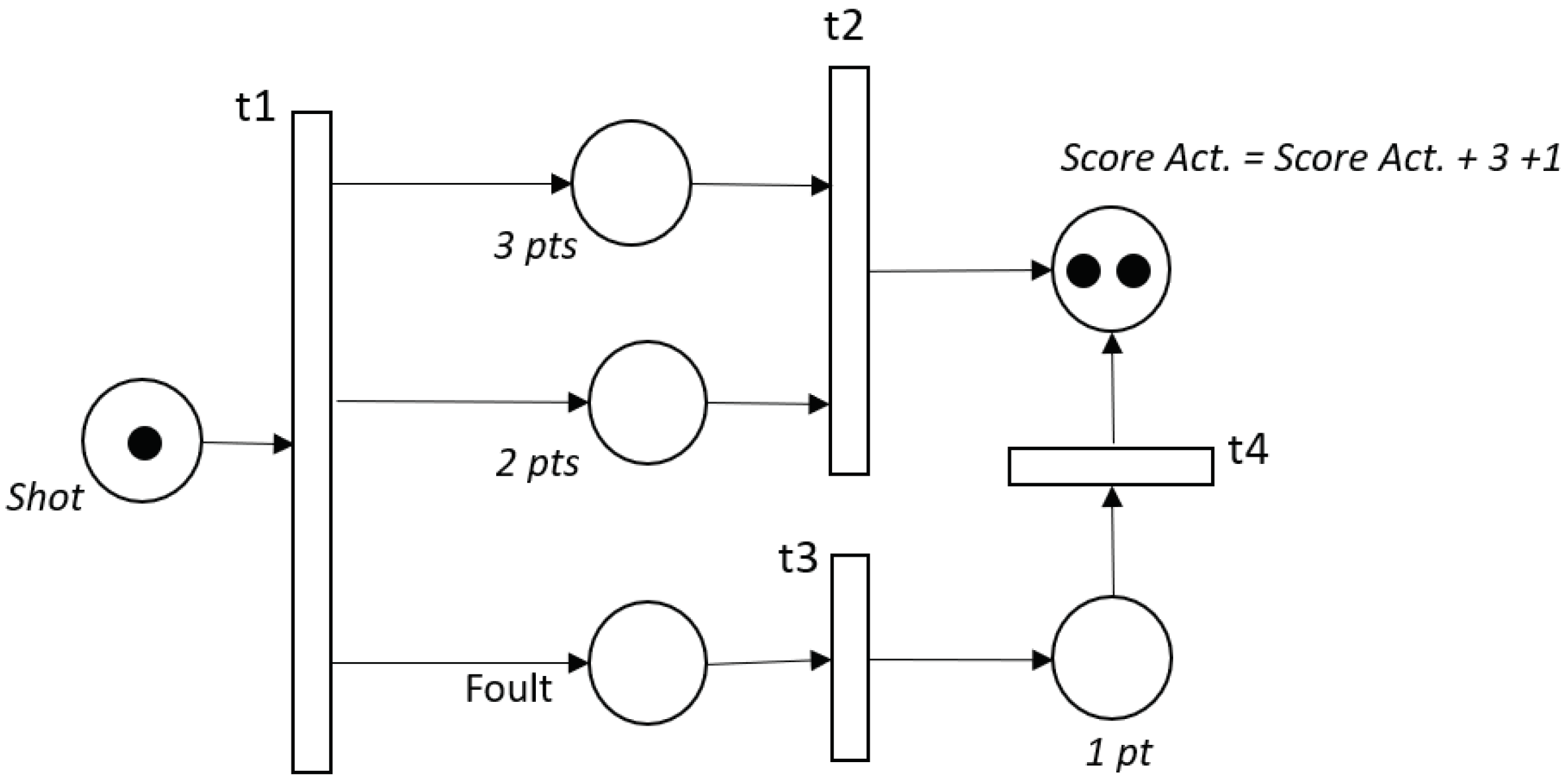
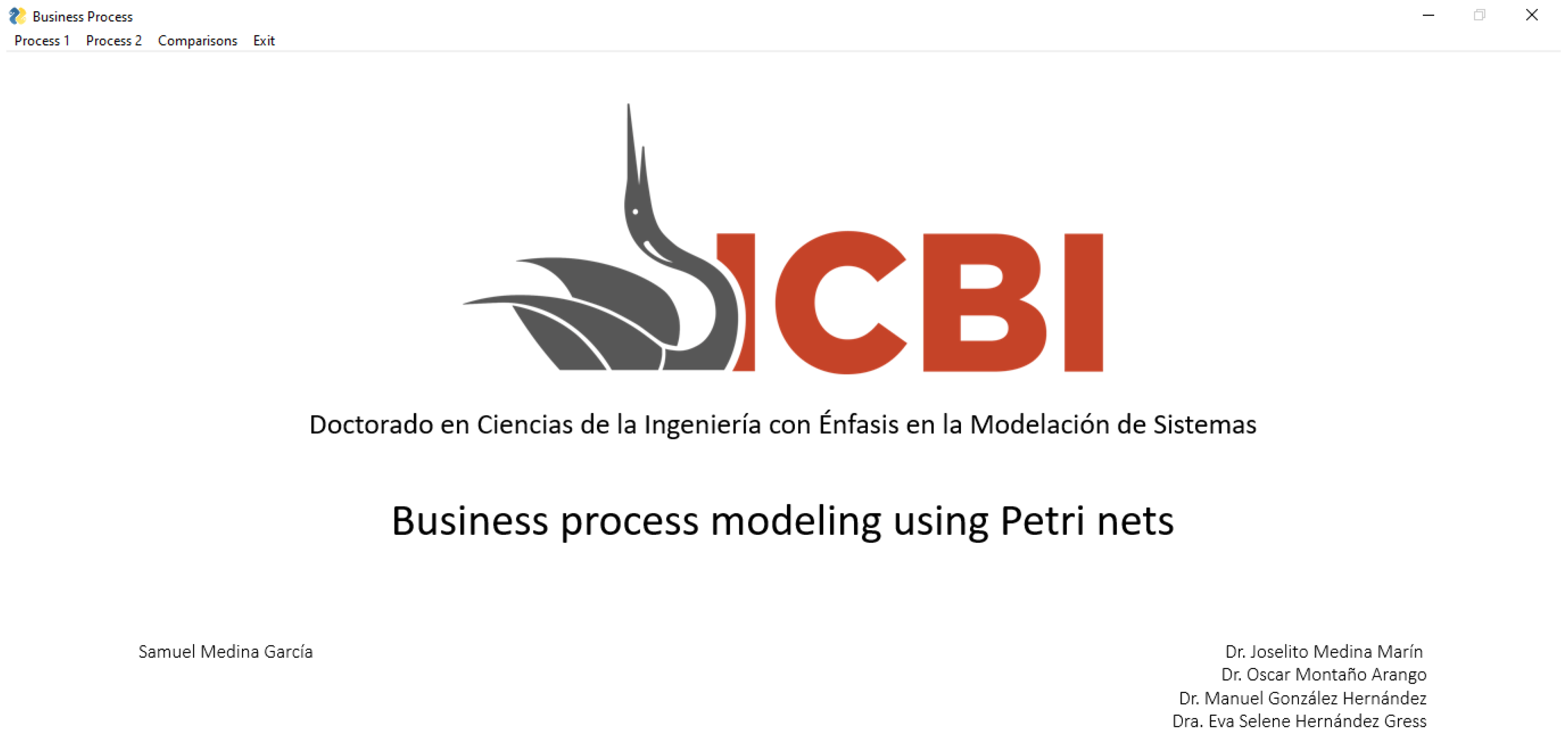
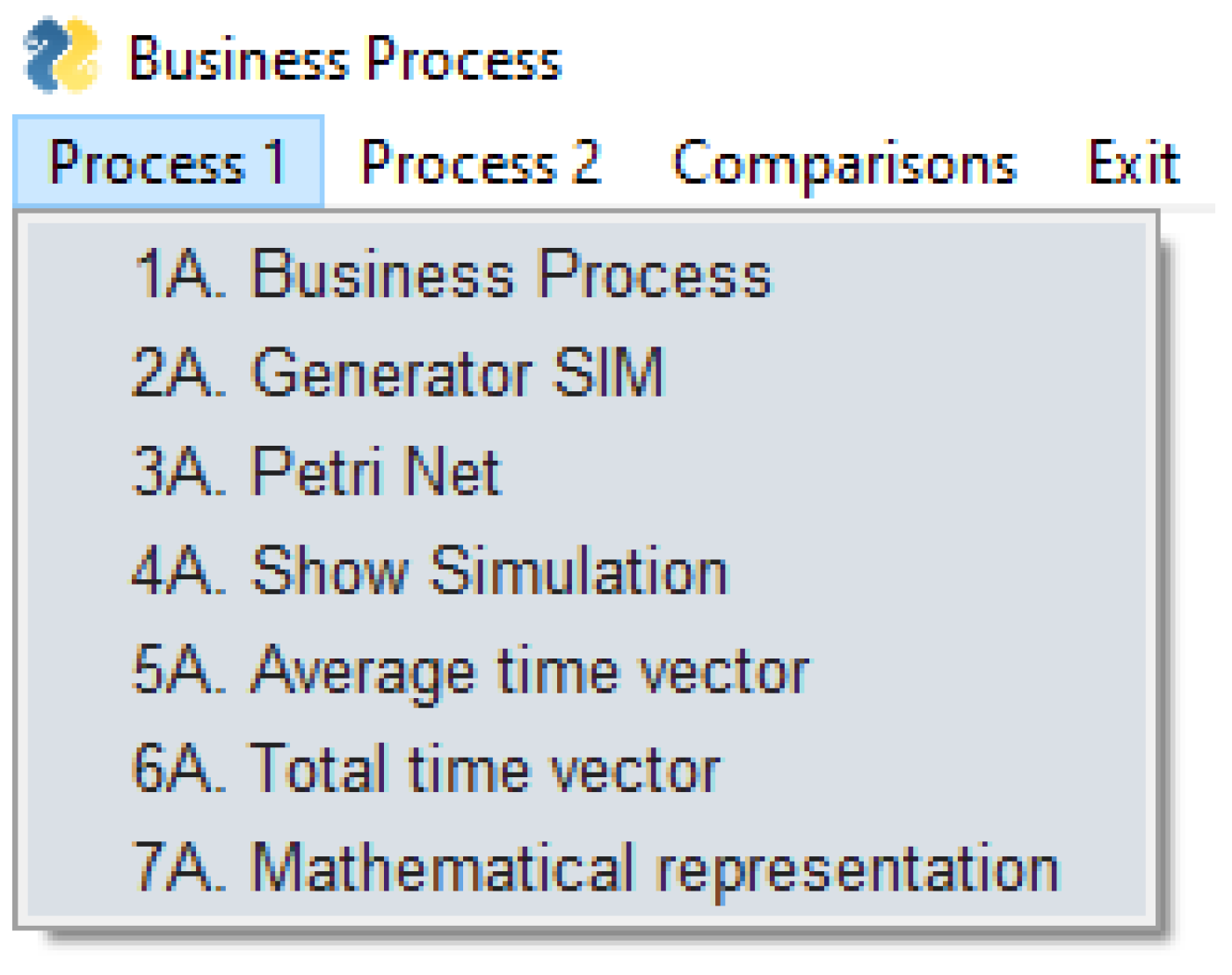


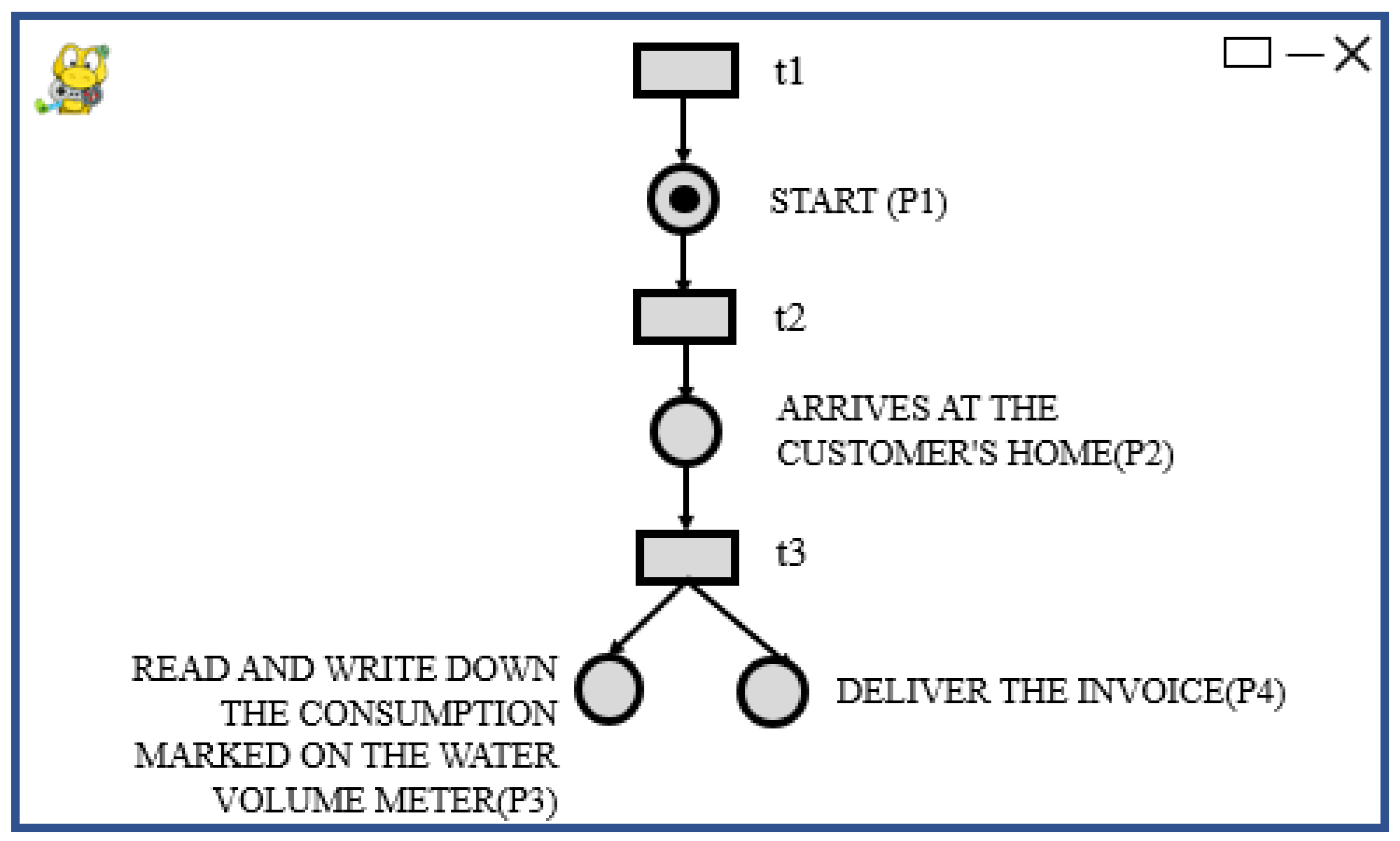



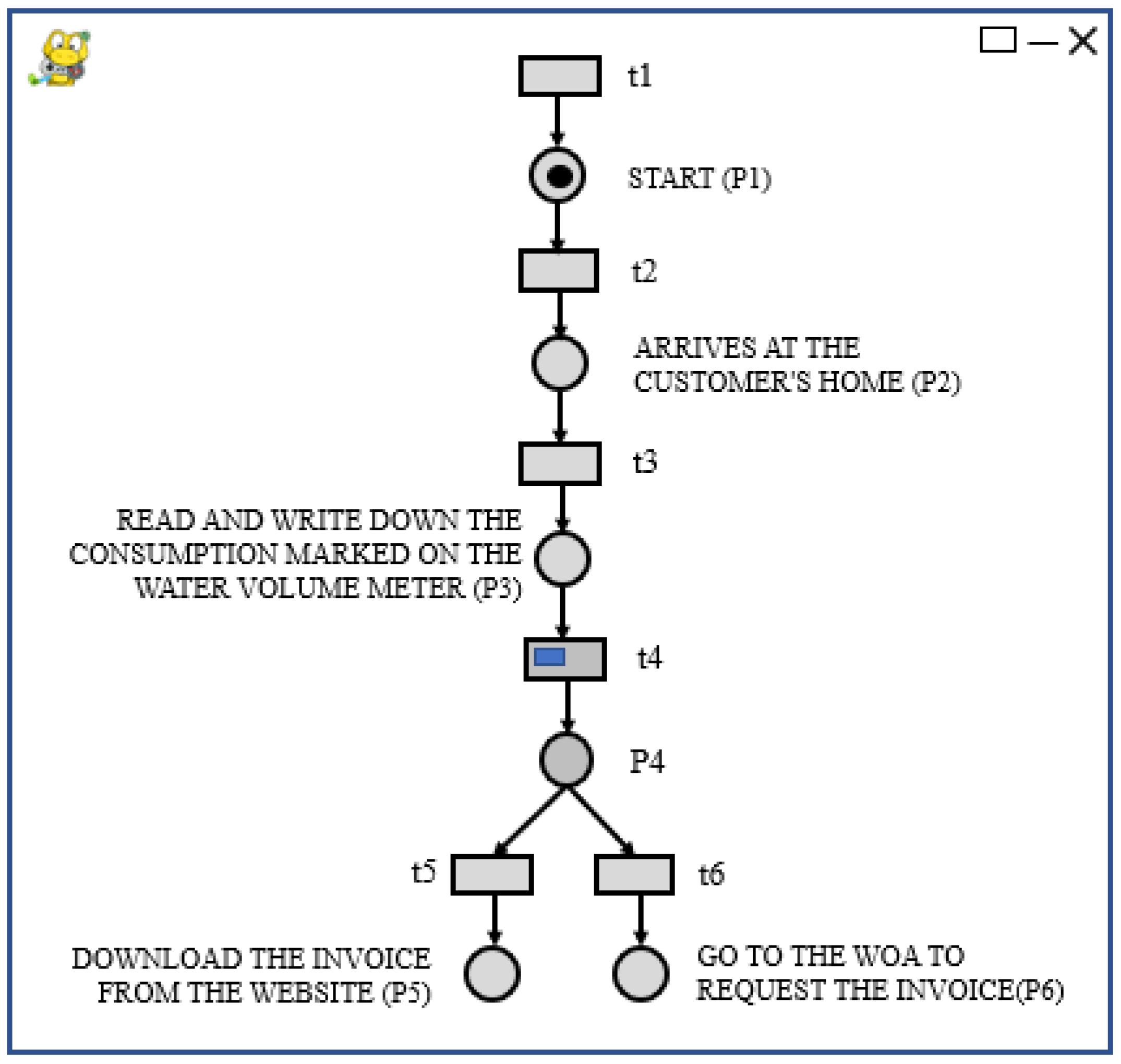
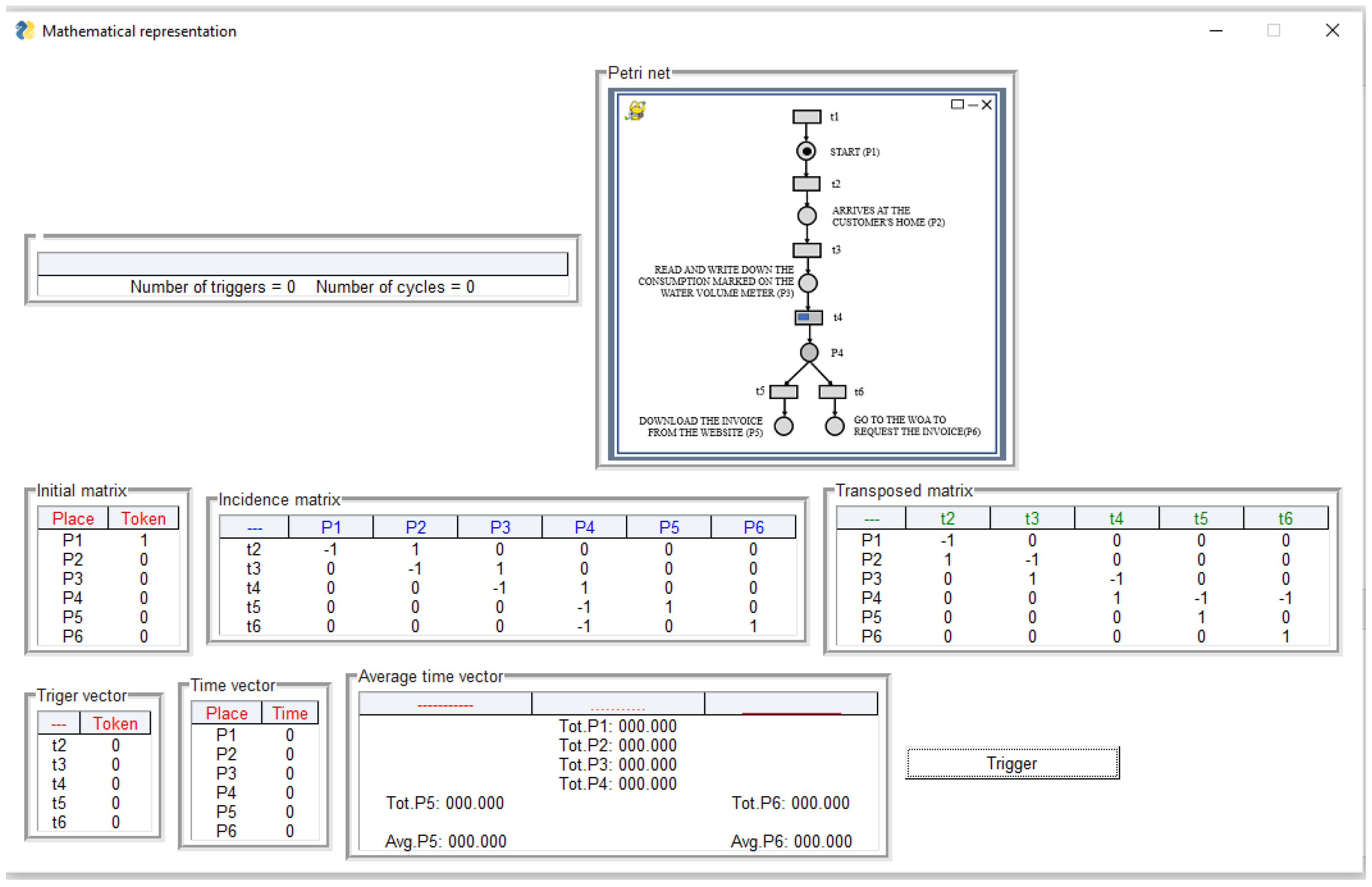
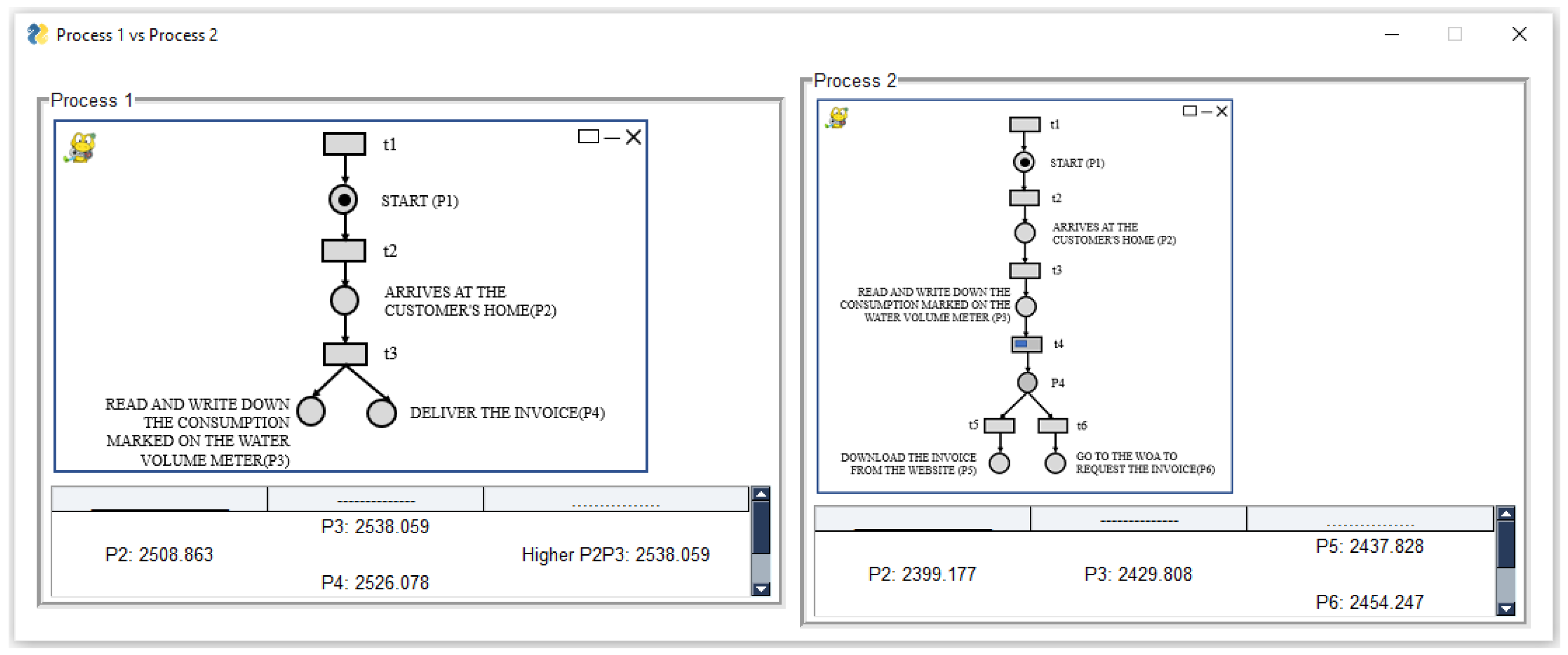
| Input Places | Transition | Exi Places |
|---|---|---|
| Preconditions | Event | Postconditions |
| Input Data | Calculation Step | Output Data |
| Input Signals | Signal Processor | Output Signals |
| Required resources | Task or work | Released resources |
| Conditions | Clause in logic | Conclusion(s) |
| Store (Buffer) | Renderer | Store (Buffer) |
| The Meter Reader Arrives at the Customer’s Home | ||||||||
|---|---|---|---|---|---|---|---|---|
| MINUTES | ||||||||
| R1 | 39 | 43 | 48 | 47 | 41 | 41 | 40 | 40 |
| R2 | 48 | 37 | 49 | 37 | 42 | 36 | 39 | 37 |
| R3 | 48 | 46 | 50 | 43 | 45 | 36 | 42 | 41 |
| R4 | 47 | 38 | 49 | 47 | 40 | 39 | 42 | 48 |
| R5 | 46 | 42 | 40 | 36 | 40 | 37 | 39 | 47 |
| R6 | 48 | 45 | 45 | 44 | 39 | 50 | 41 | 45 |
| R7 | 38 | 45 | 49 | 43 | 42 | 43 | 48 | 39 |
| R8 | 36 | 43 | 35 | 48 | 39 | 43 | 50 | 38 |
| R9 | 45 | 37 | 45 | 37 | 47 | 36 | 50 | 49 |
| R10 | 38 | 44 | 43 | 43 | 44 | 38 | 49 | 41 |
| R11 | 50 | 39 | 41 | 41 | 46 | 49 | 35 | 41 |
| R12 | 47 | 40 | 42 | 40 | 49 | 47 | 36 | 37 |
| R13 | 37 | 39 | 36 | 44 | 41 | 50 | 48 | 35 |
| R14 | 50 | 38 | 37 | 43 | 38 | 37 | 37 | 46 |
| R15 | 40 | 48 | 46 | 43 | 43 | 39 | 49 | 48 |
| R16 | 46 | 48 | 40 | 40 | 49 | 37 | ||
| Determination of Probability Distribution Act. 1 | ||||||||
| Refer to Appendix A | ||||||||
| Mean: | 42.466 min | 2547.972 seg | ||||||
| Standard Dev.: | 04.478 min | 0268.681 seg | ||||||
| Median: | 43.000 min | 2580.000 seg | ||||||
| Mode | 39.000 min | 2340.000 seg | ||||||
| Type of distribution: | NORMAL | |||||||
| Read and Write Down the Consumption | ||||||||
|---|---|---|---|---|---|---|---|---|
| Marked on the Wáter Volumen Meter | ||||||||
| SECONDS | ||||||||
| R1 | 31 | 38 | 32 | 32 | 38 | 23 | 38 | 20 |
| R2 | 32 | 42 | 28 | 43 | 20 | 24 | 29 | 37 |
| R3 | 21 | 30 | 37 | 44 | 25 | 42 | 25 | 22 |
| R4 | 17 | 29 | 29 | 16 | 19 | 27 | 40 | 45 |
| R5 | 30 | 32 | 41 | 26 | 35 | 39 | 45 | 45 |
| Marked on the Water Volume Meter | ||||||||
| SECONDS | ||||||||
| R6 | 16 | 32 | 16 | 44 | 16 | 32 | 34 | 35 |
| R7 | 29 | 37 | 25 | 44 | 30 | 44 | 38 | 45 |
| R8 | 31 | 42 | 43 | 40 | 27 | 27 | 23 | 27 |
| R9 | 45 | 17 | 21 | 16 | 27 | 18 | 44 | 43 |
| R10 | 35 | 24 | 44 | 29 | 32 | 30 | 28 | 34 |
| R11 | 18 | 42 | 35 | 44 | 21 | 35 | 37 | 15 |
| R12 | 40 | 39 | 26 | 40 | 29 | 30 | 40 | 36 |
| R13 | 26 | 17 | 19 | 33 | 37 | 16 | 27 | 36 |
| R14 | 36 | 37 | 38 | 19 | 32 | 15 | 36 | 30 |
| R15 | 44 | 16 | 45 | 42 | 36 | 45 | 33 | 34 |
| R16 | 30 | 30 | 40 | 29 | 26 | 29 | ||
| Determination of Probability Distribution Act. 2 | ||||||||
| Refer to Appendix A | ||||||||
| Mean: | 30.066 seg | |||||||
| Standar Dev.: | 08.786 seg | |||||||
| Median: | 32.000 seg | |||||||
| Mode | 32.000 seg | |||||||
| Type of distribution: | NORMAL | |||||||
| Deliver the Invoice | ||||||||
|---|---|---|---|---|---|---|---|---|
| SECONDS | ||||||||
| R1 | 19 | 17 | 17 | 19 | 25 | 24 | 24 | 10 |
| R2 | 24 | 16 | 22 | 22 | 14 | 23 | 21 | 18 |
| R3 | 15 | 18 | 20 | 11 | 21 | 10 | 22 | 20 |
| R4 | 10 | 19 | 13 | 20 | 14 | 13 | 10 | 12 |
| R5 | 14 | 25 | 19 | 11 | 14 | 22 | 15 | 17 |
| R6 | 20 | 12 | 17 | 16 | 12 | 20 | 21 | 18 |
| R7 | 24 | 21 | 13 | 19 | 16 | 23 | 25 | 21 |
| R8 | 13 | 24 | 17 | 16 | 22 | 19 | 15 | 21 |
| R9 | 21 | 24 | 24 | 18 | 17 | 25 | 25 | 24 |
| R10 | 18 | 10 | 15 | 10 | 19 | 23 | 17 | 21 |
| R11 | 17 | 23 | 22 | 23 | 23 | 18 | 13 | 13 |
| R12 | 16 | 11 | 12 | 13 | 14 | 22 | 22 | 15 |
| R13 | 18 | 13 | 11 | 24 | 19 | 13 | 13 | 10 |
| R14 | 20 | 16 | 17 | 21 | 14 | 12 | 10 | 10 |
| R15 | 17 | 22 | 18 | 21 | 24 | 22 | 13 | 18 |
| R16 | 23 | 16 | 15 | 24 | 13 | 24 | ||
| Determination of Probability Distribution Act. 3 | ||||||||
| Refer to Appendix A | ||||||||
| Mean: | 17.380 seg | |||||||
| Standar Dev.: | 04.516 seg | |||||||
| Median: | 18.000 seg | |||||||
| Mode | 24.000 seg | |||||||
| Type of distribution: | NORMAL | |||||||
| Field | Type | Description |
|---|---|---|
| id_act | Numeric | Registration number |
| tip_symbol | Text | Petri net symbol (square, transition) |
| des_act | Text | Description of the activity |
| end_act | Text | Connection or end of process |
| Field | Type | Description |
|---|---|---|
| id_number | Numeric | Simulation cycle number |
| activity | Text | Description of the business process activity |
| cost | Numeric | Activity cost (not used for this algorithm) |
| time | Numeric | Activity development time (generated by the simulator according to the probability distribution) |
| type_distribution | Text | Initial letter of the type of probability distribution used |
Disclaimer/Publisher’s Note: The statements, opinions and data contained in all publications are solely those of the individual author(s) and contributor(s) and not of MDPI and/or the editor(s). MDPI and/or the editor(s) disclaim responsibility for any injury to people or property resulting from any ideas, methods, instructions or products referred to in the content. |
© 2023 by the authors. Licensee MDPI, Basel, Switzerland. This article is an open access article distributed under the terms and conditions of the Creative Commons Attribution (CC BY) license (https://creativecommons.org/licenses/by/4.0/).
Share and Cite
Medina-Garcia, S.; Medina-Marin, J.; Montaño-Arango, O.; Gonzalez-Hernandez, M.; Hernandez-Gress, E.S. A Petri Net Approach for Business Process Modeling and Simulation. Appl. Sci. 2023, 13, 11192. https://doi.org/10.3390/app132011192
Medina-Garcia S, Medina-Marin J, Montaño-Arango O, Gonzalez-Hernandez M, Hernandez-Gress ES. A Petri Net Approach for Business Process Modeling and Simulation. Applied Sciences. 2023; 13(20):11192. https://doi.org/10.3390/app132011192
Chicago/Turabian StyleMedina-Garcia, Samuel, Joselito Medina-Marin, Oscar Montaño-Arango, Manuel Gonzalez-Hernandez, and Eva Selene Hernandez-Gress. 2023. "A Petri Net Approach for Business Process Modeling and Simulation" Applied Sciences 13, no. 20: 11192. https://doi.org/10.3390/app132011192
APA StyleMedina-Garcia, S., Medina-Marin, J., Montaño-Arango, O., Gonzalez-Hernandez, M., & Hernandez-Gress, E. S. (2023). A Petri Net Approach for Business Process Modeling and Simulation. Applied Sciences, 13(20), 11192. https://doi.org/10.3390/app132011192








